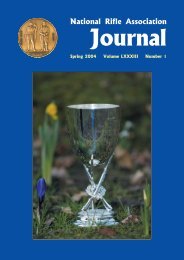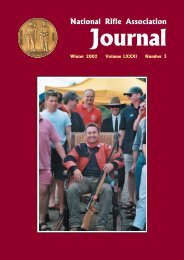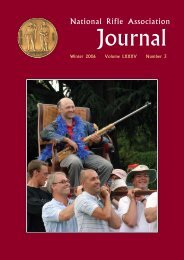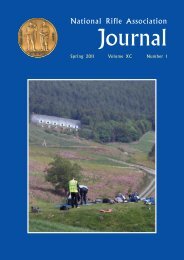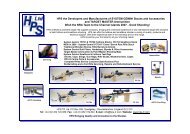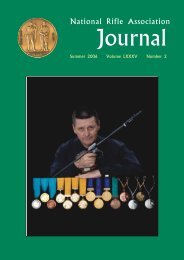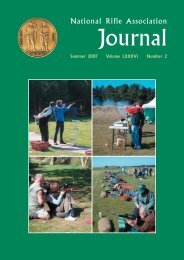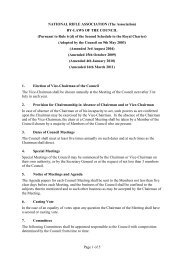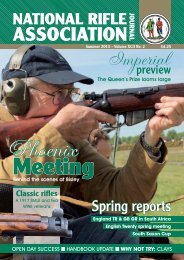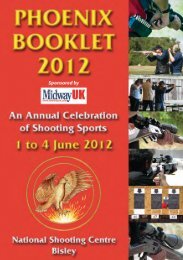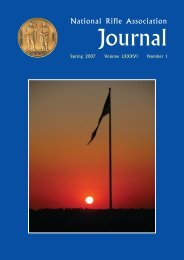NRA Journal - Summer 2003 - National Rifle Association
NRA Journal - Summer 2003 - National Rifle Association
NRA Journal - Summer 2003 - National Rifle Association
- No tags were found...
Create successful ePaper yourself
Turn your PDF publications into a flip-book with our unique Google optimized e-Paper software.
Feeling cold at the South East Practical <strong>Rifle</strong> Championship.(Photo: S Beard)The second series of six exposures was at the 200 metrestarget. Again each was of five seconds, only this timethey had to be shot from the sitting position round apost.The last series was of eight exposures shot proneunsupported. Ten seconds were allowed between eachseries of exposures to adopt the new position. Needlessto say safeties were applied during all movement. MBradley and D Livingstone tied for first place with GFlemming in third.Stage 2 was of a type becoming more familiar these daysforcing the competitor to use as many positions as theorganiser can squeeze into a single stage. In this case itwas a series of exposures of each of the three targets(falling when hit) with a different position being adoptedfor each series. At least two of the targets were to beengaged during each exposure. They were, in order,Standing, Squatting, Kneeling, Sitting, ProneUnsupported and finally, Freestyle. The stage winnerwas M Bradley followed by P Williams and S Oakland.Stage 3 (the Mogadishu Ration) was, as most of you willhave already surmised by part of the name, a variationof the now infamous Rourke’s. In this case it was withall three targets exposed for 150 seconds (not fallingwhen hit). Competitors had three magazines of tenrounds, two of which were placed about two metresbehind the point, competitors started from behind thepoint holding the remaining magazine. On theappearance of targets they had to move to the point,adopt a prone supported position, load and engage thetargets with no more than ten to count per target. So farso good and fairly straightforward. The only down sidewas that once your existing ten rounds had been used,you had to crawl to the rear to pick up the next magazine.Picture if you will your normal ETR firing point completewith very cold and very slushy snow! M Bradley, PWilliams, M Harrington and R Cooke all tied for firstplace.Stage 4 was split into two parts. The first (4a) was agood way to check whether your zero was good for theETR targetry, consisting as it did of three 6 secondexposures of the 400 metres (fig 12) target, three 7 secondexposures of the 500 metres target (fig 11) and four 8second exposures of the 600 metres (fig 11) target. Alltargets fell when hit and were shot from the pronesupported position.Next (4b) was of a single extended ripple of 40 seconds.Ten seconds after the 400 metres target appeared, the500 metres was put up and 10 seconds later the 600metres target. Shot from the prone supported positionand with unlimited rounds, (provided you wereconfident in your zero) this was a chance to check yourability to shoot fast and accurately. Targets did not fallwhen hit. S Oakland won this stage.The penultimate Stage 5 was a distant ripple. For thoseof you who are unfamiliar with this term, it is a series ofexposures starting and finishing with a single exposureof the 600 metres fig 11 target. In between these twoexposures are a series of six groups of three targets. Eachof the 4, 5 and 600 metres targets would appear twoseconds after each other for a period of six seconds eachin random order. Shot from a freestyle position this isgreat fun as if you don’t drop them in the correct orderyou’ll inevitably miss an exposure. In my case, simplybeing able to see the well camouflaged 600 metres fig 11would have been of some benefit; it was only when itwas on the move that I was able to locate a dim outline,but that, as they say, is Practical <strong>Rifle</strong>. Surprisingly yourstruly won the stage, S Oakland was second and MBradley, P Swire and P Hunter shared third.Stage 6, the final stage, had competitors standing to therear of the 600 metres firing point. On the appearanceof the 400 and 500 metres targets for 15 seconds,competitors had to move forward, adopt the proneunsupported position prior to engaging each targetwhich would fall when hit. There was then an intervalof five seconds for the competitors to adopt a supportedprone position prior to the 500 and 600 metres targetsappearing for 15 seconds, again these fell when hit.Competitors then applied safety catches prior tostanding and repeating the whole procedure to give atotal of five series of exposures. First was M Bradley,second D Green and third P Williams.Top overall three places Mark BradleySteve OaklandDave GreenTop Veteran (50 and over) Steve OaklandTop TyroG Hay••• WANTED •••7.62mm FIRED CARTRIDGE CASESTOP PRICES PAIDFOR CLEAN, UNDAMAGED BRASS.COLLECTION FROM BISLEY CAMP,OR ELSEWHERE BY ARRANGEMENT.For further information please contactA. FORD TEL/FAX 0121 453 6329ALSO REQUIRED - .303 BRASS, G.P.M.G. LINKS,CHARGER AND STRIPPER CLIPS, ETC.15



